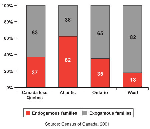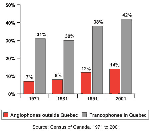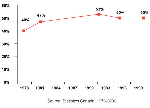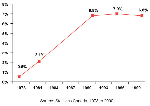3. EDUCATION
3.1 Where we are now
3.1.1 Minority French-language education: huge strides, huge challenges
3.1.2 Minority English-language education: the challenge of diversity
3.1.3 Second language learning: slowdown following real progress
3.1.4 Existing programs: federal-provincial-territorial agreements are our
lever
3.2 Our plan
3.2.1 Minority-language education: Francophone communities
3.2.2 Minority-language education: Anglophone communities
3.2.3 Second-language instruction
3.2.4 Beyond the classroom
In the area of education, the official languages policy includes two
components: minority-language education and second-language education. The
Action Plan will strengthen the Government of Canada’s ability to act in these
two crucial areas.
Our plan was developed on the basis of an analysis of the current situation.
Education is the cornerstone of the official languages policy. So our starting
point is a solid one. Let’s take a look at where we are.
3.1 Where we are now
We will begin by taking a look at minority-language education, both for
Anglophones and Francophones, and then focus on where we are in terms of
second-language instruction. We will then examine the Government of Canada’s
existing programs in these areas.
3.1.1 Minority French-language education: huge strides, huge challenges
If there is one area in the promotion of official languages where the results
have been impressive, it is the area of French-language educational institutions
in minority Francophone communities.
There were no French schools in half the provinces in 1982 when section 23 of
the Canadian Charter of Rights and Freedoms came into force giving
parents in minority-language groups the right to manage their own educational
institutions. In 1990, French-speaking minorities were running some French
schools in Ontario and all French schools in New Brunswick. Today,
minority-language groups manage schools in all provinces and territories.
Today, there are 150,000 Francophone students in 674 French schools, and a
network of 19 Francophone colleges and universities outside Quebec. Recent years
have also seen the emergence of a virtual network offering post-secondary
distance learning in French to overcome the problems of small numbers of
Francophone students and scattered clientele.
Enrolment in Francophone schools in minority communities has risen from 56%
of students eligible under the Charter in 1986, to 68% at the time of the 2001
Census.18
|
Here are some examples of successful initiatives:
-
New Brunswick: established a virtual community college network in
the Acadian Peninsula and developed programs at the University of
Moncton;
-
Nova Scotia: enhanced programming at Collège de l’Acadie and
Université Sainte-Anne;
-
Ontario: increased emphasis on French by Francophone school boards
and completed a network of Francophone community colleges;
-
The three territories and Saskatchewan: created measures to support
recovery of French-language skills;
-
British Columbia and Manitoba: introduced full-time French
kindergarten; and
-
Alberta: increased services and programs offered by the Faculté
Saint-Jean.
|
Progress in this area has been quite impressive and is due in large part to
the entrenchment of the right to manage and control educational institutions. In
cases like Mahe19 and Arsenault-Cameron20,
the courts have ensured that the “numbers warrant” provisions affecting
these management rights have not been overly demanding.
Despite these successes, minority French-language education is facing major
challenges. The problems highlighted by Francophone minorities during
consultations fall into two broad categories: recruitment and retention of
eligible school populations, and the quality of instruction in French in the
face of increasing needs.
Funding and student recruitment, however, continue to pose challenges and to
threaten the survival of small schools. When a French school is not nearby,
there is often a tendency to enroll in an English or immersion school. Without
sufficient students and funding, primary schools serving a small Francophone
community or neighbourhood will have difficulty continuing to contribute to the
life of the community. In some regions, there are few well-established secondary
schools, and limited access to post-secondary education in French discourages
students from completing their secondary school education in that language.
Parents are concerned about the quality of instruction and how their children
are being equipped for the future. They want programs, courses and options that
match those available to the majority. The results achieved by Francophone
students in standardized tests seem to justify those concerns. Such tests
invariably show deficiencies in reading and writing when compared with Canadian
averages. In science, the Anglophone sector has a significant lead in Nova
Scotia, New Brunswick, Ontario and Manitoba.21 It
is not known to what extent variations in teaching methods and environmental
factors — in particular, the dominance of English in the home — contributes
to this situation.
It will not be easy to recruit more students and at the same time improve the
quality of education. Reconciling these two objectives presents a special
challenge. Students now registered in French schools are either children whose
parents are both Francophones or children of exogamous families who already have
a good knowledge of French. Since a third of those eligible to be educated in
French say they cannot speak French well enough to sustain a conversation22,
convincing them of the advantages of French schools will inevitably demand extra
effort. Moreover, new resources will be needed to offer special assistance to
all students to address the wide variance of abilities in French, as some of
them have very little French to begin with.
Another factor to consider is that an increasing number of young Francophones
are marrying Anglophones and starting families with them. Such couples are
called exogamous couples.
|
“The more French language schools increase the intensity of their
recruitment, the more the need to provide French training increases, since
young people who are entitled to be educated in French are often nowhere
near mastering their mother tongue”,
writes
Yves Lusignan on August 7, 2002, in Le Reflet, a monthly
publication put out by the Association de la presse francophone.
|
|
Graph 1 — Percentage of endogamous and exogamous couples,
Francophones outside Quebec, 1971-2001
|

|
Exogamy is especially prevalent among young couples, who are precisely the
most likely to have school-age children. In fact, more than two thirds of
children are now part of families where only one parent has French as the mother
tongue.
|
Graph 2 — Percentage of children less than 18 years old in
Francophone families, by family type and by region, 2001
|

|
No solution can be found to the problem of improving the quality of
education, and hence academic performance, when the lack of available teachers
threatens to become more acute. For example, the proportion of teachers who will
be retiring within 10 years in Ontario is estimated at nearly 50% by Ontario’s
College of Teachers23 and nearly two thirds by
2011 in Newfoundland, according to a study done by Memorial University.24
Finally, more assistance is required by parents even at the preschool level,
because from the moment a child is born, parents are thinking about the choice
of the language of instruction. Moreover, as indicated by the Commission
nationale des parents francophones in its national early childhood development
support plan, “it is important to interest parents very early in the
Francophone system, since the birth of a child, particularly the first, marks a
moment of long-term determining choices with regard to family life. For those in
minority communities, it represents the window of opportunity for providing
active support and services in French.”25
3.1.2 Minority English-language education: the challenge of diversity
Quebec’s public school system has 360 English-language primary and
secondary institutions, and eight English-language CEGEPs and universities.
Together they have an enrolment of 102,000 students. In addition, there are
13,650 students enrolled in private primary and secondary institutions. These
young Quebec Anglophones and their parents and teachers are facing challenges
that differ from those of Francophones in other parts of Canada.
Almost all of the eligible population of English students (94%) are enrolled
in English-language schools in Quebec, compared with 68% of eligible students
enrolled in French schools outside Quebec.
It is clear that English-language instruction is attracting Quebec’s
non-Anglophone population. Up to 74% of eligible26 young
Francophones opted to attend English-language schools in 2000-2001, as did 94%
of Allophones in the same category.
Regarding the quality of education, those in English-language schools
performed as well as those in the French-language system in reading, math and
sciences. No significant gaps were found between Quebec’s two school systems
in any of the areas studied.27
But this does not mean that Anglophones do not face their own challenges.
Three issues in particular have been identified in our consultations with the
communities, found in the brief presented by the Quebec Community Groups Network
and in the available data.28 The first
challenge is adapting to a group that is becoming increasingly heterogeneous.
For example, in a recent study of the school population, the Missisquoi
Institute found that the number of Francophones in English schools almost
doubled within a 10-year period, from 10,362 in 1991 to 19,235 in 2002.29 But
this phenomenon occurs mainly outside Montreal, where Francophones make up 25%
of students in English public schools, compared with 6.2% in Montreal.
The same diversity of situations can be observed with regard to the number of
Allophones. In Montreal, the mother tongue of 28% of students in English schools
is neither English nor French. Outside Montreal, this percentage is only 11.7%.
The second challenge stems from problems associated with the small schools
(under 200 students30) being scattered
throughout certain regions of Quebec. This situation requires the development of
English-language distance education for students who would otherwise not have
access to specialized courses.
|
“We need to find the kind of opportunity that will make our students
happy and welcome in Quebec, at least partly living in French. I guess
that our challenge for the next 15, 20 or 25 years will be to make our
students truly bilingual, which means far more than simply speaking the
language.”
Alan Lombard, Executive Director,
Provincial Association of Protestant Teachers of Quebec at the Symposium
on the Canadian Experience in the Teaching of Official Languages, 1996 |
The third challenge is learning French as a second language. The Missisquoi
Institute notes that only 36% of Anglophone respondents felt that the education
they had received in French had equipped them to succeed in Quebec society.
3.1.3 Second-language learning: slowdown following real progress
Half of students enrolled in primary and secondary schools — 2.6 million
young Canadians — are learning English or French as a second language. Of this
number, 324,000 are in French immersion. This is the current situation. Let us
look more closely at this trend.
In 30 years, the percentage of bilingual Canadians has gone from 12% to 18%.
These figures, modest as they are, conceal some more encouraging progress among
young people. In actual fact, the rate of bilingualism has increased both among
Anglophones aged 15 to 24 outside Quebec and among Francophones in the same age
bracket living in Quebec.31
|
Graph 3 — Knowledge of the other official language among the 15 to
24 year-olds: Anglophones outside Quebec and Francophones in Quebec,
1971-2001
|

|
In core programs in either language or in French immersion, however,
enrolment has not risen over the last 10 years. After rising at the end of the
1970s and 1980s, enrolment in second-language programs is no longer increasing.
A recent report by Canadian Parents for French32 notes
that the quality of French second language instruction is threatened by
inadequate teaching materials, a lack of qualified teachers, and the high
drop-out rate among students in the secondary program, often due to the
impression that they will not be able to obtain post-secondary education in
French.
|
Graph 4 — Enrolment in English and French second language programs
as a proportion of total enrolment, 1978-2000
|

|
|
Graph 5 — Enrolment in French immersion as a proportion of total
English language enrolment, 1978-2000
|

|
The Government is concerned about the possible impact of this slowdown on the
ability of young Canadians to master a second language. However, according to
the annual Environics poll conducted in the fall of 200133 for
the Centre for Research and Information on Canada, 86% of all Canadians (and 82%
of Anglophones) think it is important for their children to learn a second
language. Moreover, 75% believe this second language should be French. By
comparison, 90% of Francophones who want their children to be bilingual favour
English as their second language. It seems inconceivable to the Government that
we should be unable to respond to this demand, which is apparent in every part
of Canada.
Increased bilingualism among our young people is an even more important
issue, given that interest in foreign languages is on the rise in other parts of
the world, particularly in the United States34
and Europe. Currently, Canada has fewer bilingual people than does Britain,
which ranks lowest among the European35 countries
for second-language skills.
Finally, it is important to stress the positive link between learning the
other official language by the majority and the vitality of minority language
communities. This link is clearly visible in the case of exogamous couples.
When, for example, a Francophone in a minority language situation marries an
Anglophone, the likelihood that the children will learn French is only 32% if
this spouse is unilingual, but jumps to 70% if the spouse speaks French
fluently.
|
Graph 6 — Transmission of French by knowledge of French of the
non-Francophone parent, Canada less Quebec, 2001
|

|
The learning of a second official language by the majority is increasingly an
asset for the future of minority communities. This is a critical issue, which we
will come back to in Chapter 4 on community development.
3.1.4 Existing programs: federal-provincial-territorial agreements are our
lever
In addition to court decisions, there is no doubt that action by the
Government of Canada has played an important role in minority-language education
and second-language instruction.
Because education is a provincial responsibility, the Government of Canada’s
official languages policy in this area mainly takes the form of a partnership
with the provinces and territories. Since 1971, the Official Languages in
Education Program has been a key instrument in this partnership. It governs
minority-language education and second-language instruction.
Within this program, federal transfers are effected through a five-year
memorandum of understanding with the Council of Ministers of Education, Canada
on general objectives, and bilateral agreements with each province and
territory. This procedure is designed to respect areas of responsibility and to
take into account the various situations in each region of the country. Each
provincial or territorial government developed a multi-year action plan that
includes minority-language education activities, second-language instruction,
and awareness of the culture of the other official-language community. The
agreements expire in 2003 and will be renegotiated.
In addition, in 1993, the Government undertook special education measures to
provide ad hoc support through bilateral agreements, but outside the memorandum
of understanding. These measures strengthened management of French schools and
led to the creation or consolidation of post-secondary institutions in various
provinces. They gave rise to Ontario’s network of community colleges and
consolidated institutions in Alberta, New Brunswick and Nova Scotia. In 1999,
the Investment in Education Measures succeeded this initiative, with agreements
that expire in 2004.
Two programs by the Department of Canadian Heritage promote
federal-provincial-territorial co-operation to help youth throughout the country
improve their proficiency in the other official language. They give participants
an opportunity to travel in Canada and to forge ties with citizens of the other
official language while improving their language skills or helping others to do
so. The Summer Language Bursary Program enables young people with at least grade
11 to learn their second language or enables minority Francophones to improve
their own language. The Official Language Monitor Program gives young people the
opportunity to work full time or part time with one teacher in the classroom.
These initiatives both come out of the Official Languages in Education Program
and are governed by the same memorandum of understanding with the Council of
Ministers of Education, Canada.
Over the last several years, programs funded by the federal government to
foster interest in bilingualism on the part of young people have been weakened
by insufficient resources. The Summer Language Bursary Program, for example, has
seen 200,000 young people take part in exchanges since 1973. It currently gives
7,500 young Canadians the chance to improve their second language at a
post-secondary institution, but receives twice as many applications as it can
accommodate. Created in the same year, the Official Languages Monitor Program
has benefited 30,000 young people at the post-secondary level. For reasons that
have nothing to do with its quality, the program is no longer recruiting enough
candidates to meet the demand from educational institutions. Provincial and
territorial managers of the program attribute this decrease to the low pay
received by monitors ($12,500 for nine months of full-time work and $4,000 for
part-time work), at a time when the job market can offer more.
It is crucial to act now to help communities overcome challenges in
education, revitalize second-language instruction in Canada, and ensure that
Canada remains a leader in the field.
3.2 Our plan
The Government of Canada is reinvesting in minority-language education and
second-language instruction. It is devoting the necessary funds to that end. It
is adding to the existing $929 million over five years an additional amount of
$381.5 million.
In addition to increased funding, more stringent objectives are required to
meet the challenges we are facing. That is why this additional funding will be
split into two new funds, one for Francophone or Anglophone minority-language
education ($209 million), and one for second-language instruction ($137
million). With its partners, and fully respecting their constitutional
jurisdiction, Canadian Heritage will seek to fund projects with clear objectives
designed to achieve the results outlined below for Canadians.
In addition to these two funds, the Minister of Canadian Heritage will renew
the Framework Agreement and federal-provincial-territorial agreements under the
Official Languages in Education Program at current funding levels. These
agreements will be accompanied by action plans that will specify the objectives
and agreed upon results. The Minister will also increase the budgets for the
associated Official Language Monitors Program and Summer Language Bursary
Program ($35.5 million in all by 2007-2008).
3.2.1 Minority-language education: Francophone communities
INCREASE THE NUMBER OF ELIGIBLE STUDENTS ENROLLED IN FRANCOPHONE MINORITY
EDUCATIONAL INSTITUTIONS OUTSIDE QUEBEC
The proportion of eligible students enrolled in French schools rose from 56%
in 1986 to 68% in 2001.36 The objective in
our Action Plan is to bring this percentage up to 80% within 10 years. To
achieve this goal, the Government intends to:
1. Improve student recruitment and retention
With the help of the new support fund for minority language education, the
Government will seek to provide educational institutions with quality programs
that are comparable to those available to the majority. Francization measures
and special support for students at risk will receive the closest attention.
Retention will also be a priority: young people must be encouraged to stay in
the French school system, particularly as they move on to the secondary level.
Francization begins in early childhood, and the Government will be
encouraging provinces and territories to suggest measures for providing access
to day cares and kindergartens in community schools. In addition, it will seek
to create school community centres as the focal point for community activities
in French.
2. Increase the number of qualified teachers
The Government will assist provinces and territories in teacher recruitment,
training and development. Specific objectives will be established with each
province and territory.
IMPROVE ACCESS TO POST-SECONDARY EDUCATION
The new investments will also seek to facilitate the transition to the
Francophone post-secondary level. To improve access to education, the Government
will expand the range of French-language programs in Francophone or bilingual
colleges and universities. In some regions, for example, it might encourage
linkages through agreements with Francophone institutions in other regions, but
physically located in Anglophone colleges and universities. Canadian Heritage is
examining serious proposals to this end.
Finally, the Government will consider distance learning projects submitted by
provinces and territories.
3.2.2 Minority-language education: Anglophone communities
SUPPORT FRENCH-LANGUAGE INSTRUCTION FOR ANGLOPHONES AND EXPAND OPTIONS
AVAILABLE TO STUDENTS OUTSIDE MONTREAL
Through its longstanding partnership with the Government of Quebec, the
Government of Canada will offer support for enhanced French-language instruction
in Anglophone minority schools.
Being conscious of the concerns of Anglophone parents, particularly as
expressed by the Quebec Community Groups Network (QCGN), the Government will pay
special attention to distance learning program proposals that extend the range
of options for students in small secondary schools in outlying areas and
increase the educational opportunities for post-secondary students outside
Montreal. To revitalize Anglophone schools in smaller centres, some priority
requirements like the establishment of community education centres could also be
the subject of bilateral discussions. Experience in minority Francophone
environments has demonstrated that using school buildings and providing
additional areas for community use provides the vital space in which the
community can build its identity and shape its contribution to society as a
whole.
3.2.3 Second-language instruction
DOUBLE THE PROPORTION OF SECONDARY SCHOOL GRADUATES WITH A FUNCTIONAL
KNOWLEDGE OF THEIR SECOND OFFICIAL LANGUAGE
Today, the proportion of bilingual Francophones and Anglophones in the 15 to
19 age group is around 24%. The objective of the Action Plan is to raise this
proportion to 50% by 2013. The federal government will provide assistance to the
provinces and territories to achieve this objective, which is quite realistic.
Experience shows it is possible to increase bilingualism among young people.
Half of Anglophone Quebecers between 15 and 24 had mastered French in 1971,
while eight out of 10 had done so in 2001. The proportion of Francophone
Quebecers the same age with a command of English rose from 30% to 38% between
1981 and 1991. In 15 years, between 1981 and 1996, the proportion of Anglophones
outside Quebec able to express themselves effectively in French rose from 8% to
15%.
Today, we have learned from these experiences: teaching methods have been
enhanced, we now know how to teach languages more effectively. In addition, this
is the first time such an objective has been proposed to Canadians, which is in
itself a motivation to succeed. Yes, it is possible to ensure that in 10 years
one young Canadian out of two will master both official languages.
Funds for second-language instruction will make it possible to agree with the
provinces on targeted action to:
1. Improve core English and French
Improving second-language instruction means in part renewing teaching
approaches and tools used in regular English and French classes. The Government
will encourage the examination of innovative methods, such as teaching physical
education and art courses in the second language; the compact or block
scheduling already tested in Ontario; and the intensive English instruction
tried in a number of schools in Quebec, based on the condensed French courses
provided to young immigrants.
2. Revitalize immersion
A number of strong measures provided for in the Action Plan will help to
revitalize this form of instruction. With more teachers, better quality
instruction, more accessible and better-quality teaching materials, more summer
jobs, more exchange programs, a great opportunity for students to consider
post-secondary education in their second language, it will thus be possible to
much more effectively respond to the desires of parents and students for access
to high-quality immersion. Funding will be injected into promoting this type of
instruction, and inform young people and parents of its advantages, and indeed
of its existence.
The Government of Canada will work closely with the provinces and territories
to achieve this goal. They are the governments with the constitutional
jurisdiction. They have let us know they are willing and ready to strengthen our
partnership in support of immersion. The Government of Canada will help them
open additional classrooms and modernize their teaching methods.
3. Increase the number of qualified teachers
In order to increase the number of second-language teachers, the Government
will support initiatives that the provinces and territories could present to
recruit future specialists, train them, and provide them with professional
development opportunities.
4. Provide bilingual graduates the opportunity to put their skills to good
use
Through summer jobs and exchange programs, young Canadians will get the
chance to experience the practical benefits of their knowledge of both official
languages.
3.2.4 Beyond the classroom
IMPROVE BURSARY AND MONITOR PROGRAMS
Young people for whom the programs were intended still like the Official
Language Monitor and Summer Bursary Programs; they have remained in favour with
the provincial and territorial managers who administer them. However, they need
a little push to maintain their momentum.
|
“[These] programs help … foster new ties among many Canadians, who
learn to understand and appreciate the value of linguistic duality to
Canadian society by learning their second official language.”
Canadian
Heritage, Official Languages Annual Report 2001-2002, Message from the
Honourable Sheila Copps, p. i
|
The Government has therefore decided to open the monitor program to a greater
number of young people, with a 10% to 15% increase in the number of participants
in relation to their current number (from 889 in 2000-2001 to over 1,000). In
addition, the annual salary for monitors will be raised by 10%. In total, the
Government will be investing up to $10.8 million annually in the program,
compared with $6.8 million previously, a gradual increase that will reach 59% in
the plan’s fifth year.
Investment in the Summer Language Bursary Program will total $19.4 million in
2007-2008, an increase of 70% in comparison with the current budget of $11.4
million. These funds will bring the amount of individual bursaries up by 10%
($1,635 in 2001-2002). By 2007-2008, nearly 10,000 participants will be accepted
into the program, an increase of almost 2,000.
HELP PROMOTE RESEARCH
The situation of minority official language communities, like the questions
posed in connection with second-language instruction, have long sparked the
interest of Canadian university researchers. Indeed, these researchers are
recognized as global leaders in the field of second-language instruction. The
Social Sciences and Humanities Research Council (SSHRC) contributes some $1.7
million a year for these areas. Such an investment helps expand knowledge about
the challenges facing minority official language communities and provides
avenues for public policymaking. Despite these efforts, much remains to be done
to identify problems and consequences.
The new strategic research thrust recently adopted by the Council —
Citizenship, Culture and Identity — provides a promising framework for funding
new studies on these questions. While continuing the support provided through
its regular programs, SSHRC will explore the possibility of partnerships in the
new field of strategic research, and in so doing, will help renew relevant
research.
* * *
Nothing is possible in the field of education without the provinces and
territories. The two new funds will provide them the opportunity to propose
initiatives they feel are best suited to their specific contexts. In addition,
the Action Plan will support programs that have proven themselves and require
resources to continue. If we meet our objectives, for example, if eight out of
10 eligible Francophones receive an education in their own language, and if half
of our high school graduates master both our official languages, all of Canada
will benefit. To achieve our goals, we will all need to work together as a team.
This includes students, teachers, parents, educational institutions, school
boards and governments.
-
Data from the Census of Canada, 2001. In 1986, there were 152,225 children
in francophone minority schools and 271,914 children eligible to these
schools under section 23(1). The student/eligible population ratio was 56%.
In 2001, there were 149,042 children in francophone minority schools and
219,860 children eligible to these schools, for a ratio of 68%. This
percentage indicates the extent to which the francophone minority school
system succeeds in attracting its target population.
-
Mahe v. Alberta, [1990] 1 S.C.R. 342.
-
Arsenault-Cameron et al. v. Prince Edward Island, [2000] 1 S.C.R.
3.
-
Measuring up, the performance of Canada’s youth in reading,
mathematics and science, Organization for Economic Co-operation and
Development, PISA study — First results for Canadians aged 15, p. 25.
-
Angéline Martel, Rights, schools and communities in minority contexts,
1986-2002, Study conducted for the Office of the Commissioner of Official
Languages, 2002.
-
“Teacher Supply Report”, published in the quarterly magazine of the
Ontario College of Teachers entitled Professionally Speaking,
December 1998.
-
Dr. Robert Crocker, Faculty of Education, Memorial University of
Newfoundland, “Teacher Supply/Demand in Newfoundland and Labrador:
1998-2010", November 1998.
-
La Commission nationale des parents francophones, “Plan national d’appui
à la petite enfance”, unpublished, January 2002.
-
Under the Canadian Charter of Rights and Freedoms, Canadian
citizens have the right to have their children educated in English: if they
received their own primary instruction in Canada in English, or if they have
a child who has received or is receiving his or her education in English in
Canada.
-
OECD, Measuring up, PISA study. (Note 21).
-
Jack Jedwab, The Chambers Report, Ten Years After: The State of English
Language Education in Quebec 1992-2002, Missisquoi Institute, January
2002.
-
Missisquoi Institute – CROP, Survey 2000.
-
English School Boards Association, unpublished survey, 2002.
-
Census of Canada, 1971-2001.
-
Canadian Parents for French, The State of French Second Language
Education in Canada, 2001.
-
Centre for Research and Information on Canada, Portraits of Canada 2001,
January 2002.
-
Gallup Poll, April 2001.
-
Commission of the European communities, Eurobarometer (note 5).
-
Census of Canada, 2001.
[Previous
chapter][Table
of Contents][Next
chapter]

|



